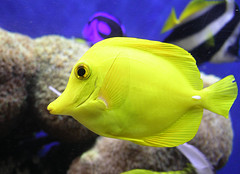What is pH and Acid and how are they related?
The pH (Power of Hydrogen) is the measuring unit of acidity or alkalinity on the water.
The degree of acidity or alkalinity is determined by the amounts of acids and bases in the water. It ranges from 0 to 14.
If both are present in equal proportion (as in pure water), then it is neutral or 7. A reading of 1 is very acidic and a reading of 14 is very alkaline.
pH is measure on a logarithmic scale, meaning that each point is ten times greater or lower than the one before. Lets say an increase from 8.1 to 8.2 means the level has raised ten times.
So this means that when it rise, a huge change in the water chemistry happened.
Saltwater is alkaline, one characteristic of saltwater is having a high pH level. It should be about 8.2 for saltwater. You must maintain this level or a range within 8.1 to 8.3.
Low pH in saltwater aquarium is hazardous and will result in excess toxic ammonia.
It is very important to maintain the correct pH and to avoid changes in pH.
When pH fluctuates

The amount of carbon dioxide and fish wastes in the water influence the pH in your aquarium. Too much will cause the waters pH to drop.
A quick fact is that during nitrogen cycle, acid is produced and alters the pH in your saltwater aquarium.
It is always good to have a pH test kit in handy. This is important when monitoring the quality of your aquarium water. It is also pretty simple and easy to use.
Try monitoring the pH and acid level every week to detect any changes. When you experience a large drop, this means that there is an increase in carbon dioxide or the nitrogenous fish wastes.
Another solution is to aerate the water and a partial water change. This will help in keeping the normal pH level.
There are two ways on maintaining pH level in its normal saltwater range.
First the saltwater itself has buffering capacity. It is the ability of a solution to resist changes in pH.
It is capable of maintaining the correct pH in spite of all the activities going on in your saltwater aquarium.
Second is it will take care of itself as long as the rules on feeding, stocking saltwater fish and other invertebrates and water changes are followed.
There are a lot of commercial salt mixes that contain buffers. It keeps the pH from falling. But over time, the buffering capacity of your water will decrease and carbon dioxide or waste build-up will cause the pH to drop.
What are the solutions?
Routine water changes will maintain your pH and acid at desirable levels. But if it falls out of the acceptable range, try restoring it by following this simple guideline.
- Use a commercially manufacture aquarium buffer. Be sure to follow the manufacturers instructions carefully.
- Add a solution of calcium hydroxide. It is commonly called kalkwasser or limewater. It helps boost calcium level so ph also increases.
Return to Most Often Tested Water Parameters
